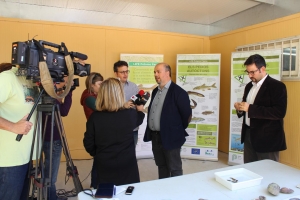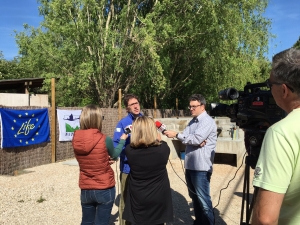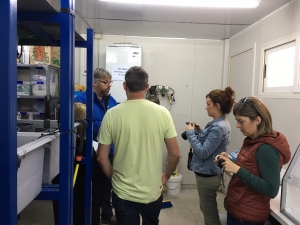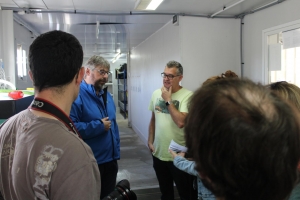The LIFE Potamo Fauna increases the production of naiads and improves the breeding center managed by the Consorci de l’Estany
- For the first time, youth naiads have been bred “in vitro” - On May 9th, the works and the results were presented at a press conference
One of the aim of the European project LIFE Potamo Fauna "Conservation of river fauna of Community interest in the Natura 2000 network sites of the Ter, Fluvià and Muga river basins" the recovery and consolidation of two species of long naiad (Unio mancus and U. ravoisieri) (= U. elongatulus) have been managed, through different conservation strategies: the captive breeding and release of juveniles produced, the reinforcements by translocations of adult population, and also a direct infestation of wild fish by naiads larvae. All these actions have been carried out to ensure the conservation of these species that are at risk of extinction in a medium term. For every action, in addition, protocols have been developed for their proper development.
The naiads are a freshwater bivalve, mussels, and they live half buried in the sediment and feed by filtering particles from the water. These species are biomarkers, and show environments that keep in good condition, and most are protected as they are in a vulnerable situation. They also have a life cycle very curious, because the larvae parasitize naiads and they need to live for a time in a host fish. Each species of fish naiads has a certain host, generally native fishes
Improved facilities in the breeding naiads laboratory
This center, managed by the Consorci de l’Estany is one of the few captive breeding centers of naiads operating in Europe, and one of the only three focused on the reproduction of these species in particular. It has increased the productivity, up to the current date. Under the LIFE Potamo Fauna the facilities of the laboratory have been improved. It was first launched as part of a previous LIFE (LIFE08 NAT/E/000078), and has the aim of having different production lines for youth naiads in the different basins which works in LIFE Potamo Fauna: Ter and Fluvià, as well as to ensure increased global productivity.
The expansion took place at the beginning of the project, the first half of 2014. Specifically, 27 tanks from 70 liters-tank for the maintenance of fish infected have been bought, and also six new tapered cylinder of 300 liters for the collection of juvenile infected fish. The project has also built a system of 16 channels where youth from different populations have been separated from naiads that are grown each year of production, and also to maintain the genetic differentiation of the species that have different origins for each river basin. In addition, specific improvements have been made in the system of environmental control, aeration, water circulation, control of pollution of the environment, the system of infection and maintenance of fish, and in the collection of youth.
Moreover, during the winter of 2015 and spring of 2016, a new expansion of the laboratory began, with three prefabricated modules that have allowed the tanks to redistribute and install new deposits of fiberglass channels.
Results captive breeding
The reproduction in captivity of the naiads in the Project LIFE Potamo Fauna laboratory began in 2014. So far, between May and July of each year (in 2014, 2015 and 2016), there has been a variable number, but always high-born specimens that have been planted in sediment tanks, swimming pools and especific channels for growth. There were youth from two different species, including both Union elongatulus within the group, and five different populations (Fluvià, Ser, Llémena and Brugent rivers and also the Lake of Banyoles).
|
Naiad species (U. elongatulus) |
River and river basin |
Juveniles produced 2014 2015 2016 |
|
Unio mancus |
Brugent river (Ter) |
39 808 96 094 29 736 |
|
Unio mancus |
Fluvià river (Fluvià) |
36 254 56 987 27 130 |
|
Unio mancus |
Ditches lake of Banyoles (Ter) |
23 878 13 993 58 282 |
|
Unio mancus |
Llémena river (Ter) |
12 924 29 032 68 968 |
|
Unio ravoisieri |
Lake of Banyoles (Ter) |
17 196 4 759 56 296 |
|
Unio ravoisieri |
Ser river (Fluvià) |
4 593 - - |
|
Total |
|
134 653 200 865 240 428 |
The youth have had a good growth rate, but regarding that ones that are in the external sector, survival has fallen below 5%, even below 1%. This such high mortality of these species is normal, and is the main challenge to improve laboratory productivity in the future. Therefore, not all born specimens have been used to repopulate the rivers. Therefore, improvements and extensions carried out between 2015 and 2016, they stood inside the laboratory to increase the survival of the specimens obtained.
In 2015, through several tests, a new method to significantly improve the survival of naiads, was obtained during the first months (median survival 36.5% of the year), and also allowed a continuous monitoring of stocks. It consists in maintaining seed naiads sieves suspended in tanks and make the renovation of the pond water circulation and provide supplementary food made from concentrated and lyophilized seaweed.
Also, last year, an intensive pioneer test for obtaining juvenile naiads without fish (in vitro production) took out. Glochid (larvae naiads) were culture placed in a stove under controlled conditions. The test was a success, reaching a total of 3,300 juveniles. This milestone is very important for the ex situ conservation of naiads in the future as it will significantly increase the productivity of this center and others, and reduce production costs.
Population reinforcements
During 2017 it will be released most of the laboratory individuals that have been bred, at least 2000. So far, there have been releases on the lake of Banyoles. A total of 177 new individuals in five locations.
Furthermore, translocations have been held in 2016; 300 individuals were translocated to localities such as Brugent, Llémena, Ser and Ter rivers.
Tracking stocks
The monitoring is carried out to ascertain precisely the starting state of the populations of this species within the area covered by the project, as well as to know their evolution during the duration of it. These began in June 2014 and have provided all sectors surveyed: specific stretches of rivers Brugent Llémena Riudelleques, Ter, Fluvià and Ser and also the Lake of Banyoles. A total of 98 stations have surveyed the entire scope of the project.
In total, in all the 26 river stretches in the presence of Union elongatulus have been captured or recaptured some 10,000 individuals, of which 1,400 were marked by growth and demographic studies. In the area of Banyoles about 4,500 have been captured or recaptured so far, of which approximately 30% were marked or have been marked.
Reinforcements and monitoring of Mediterranean Barbel (Barbus meridionalis) population and other elongated naiad guests fishes
The naiads production process includes the following phases:
1) Obtain glochid of adult naiads
2) intensive fish infestation with local host glochid
3) Isolation of infected fish to get recently detached youth naiads
4) Planting in containers youth growth
Because this production can occur in the environment, what has been done in parallel at the same time in the project it has been the recovering of the populations of Mediterranean Barbel (Barbus meridionalis) and other native fish, where there had stable populations. So fish translocations have been done from the same catchment areas with populations in good condition.
In the spring of 2015 and 2016 a total of 886 individuals of Feshwater Blenny (Salaria fluviatilis) were translocated. That was from the middle of the river Fluvià to the middle-high in a sector where the species had disappeared at least for three decades and where there are still small populations of naiads.
In the Ter basin, in the autumn of 2015 and in 2016 again a total of 851 individuals of Catalan Catfish (Squalius laietanus) have been translocated. They were from the upper reaches of the river to the middle of the river Llémena, where this species had practically disappeared and where one of the most important Unio mancus population is found.
In 2016, 226 specimens of Freshwater Blenny (Salaria fluviatilis) were translocated from the lower course of the river Ter to the middle one, in a section where the species had disappeared. In addition, Catalan Catfish (Squalius laietanus) from the Terri river to the Brugent river (up to 522 individuals), to riera d’en Xuclà (155 individuals) and to the lake of Banyoles (162 individuals). Also several Barbels were brought to the ditches of Banyoles (122 individuals).
This year 2017, the reinforcements will continue through new translocations. The monitoring also have been done regularly.
The project LIFE Potamo Fauna
LIFE Potamo Fauna, a part of the Naiad Unio elongatulus, also preserves other endangered species as the European Pond Turtle, the White-clawed Crayfish (Austropotamobius pallipes), Mediterranean Barbel (Barbus meridionalis), Desmoulin’s Wnorl Snail and Narrow-mouthed Wnorl Snail (Vertigo moulinsiana and Vertigo angustior) and Mediterranean Turtles (Mauremys leprosa) and various amphibians. It also fights various alien invasive species and performs outreach and awareness campaigns on the river fauna threatened.
The whole project has a budget of 1.900,262 euros, 50% funded by the European Union.
LIFE Potamo Fauna is implemented and coordinated by the Consorci de l’Estany in conjunction with the Department de Territory i Sostenibilitat, Forestal Catalana, Amics de les Tortugues de l’Albera and Universidad del País Vasco-Euskal Herriko Unibertsitabea, with also the financial participation of Diputació de Girona, Ajuntament de Banyoles, Ajuntament de Porqueres, Consorci Esportiu de l’Estany de Banyoles and Aigües de Banyoles.




















